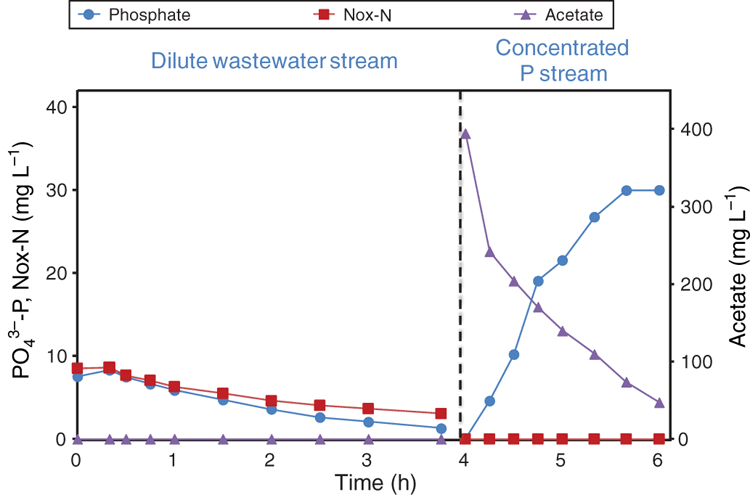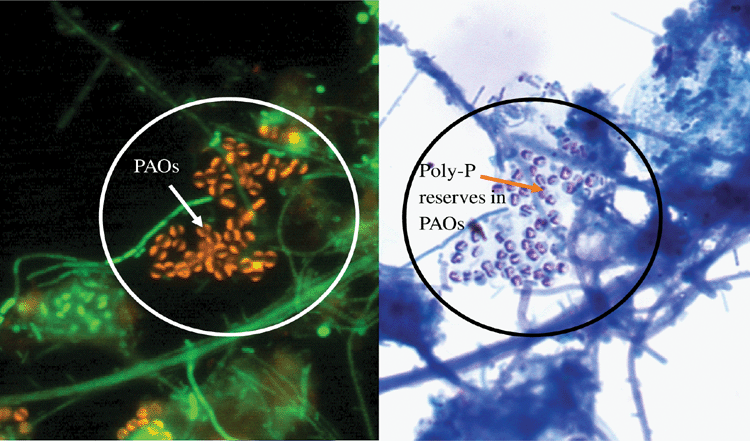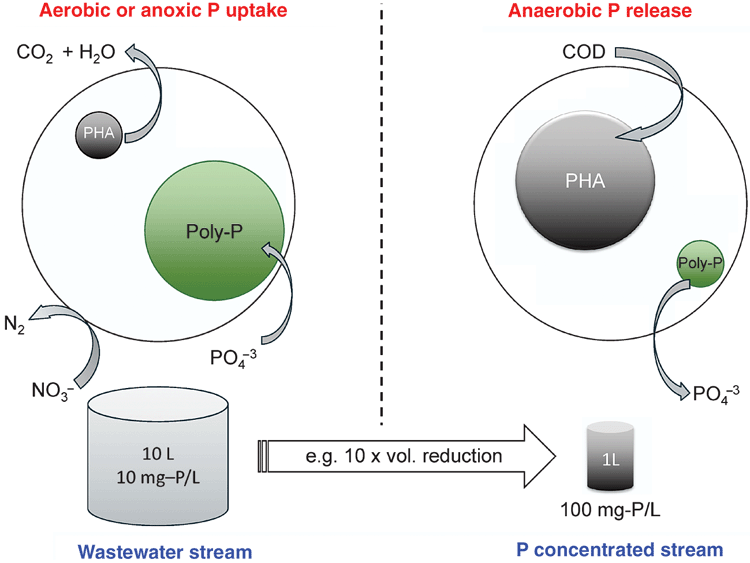Biological recovery of phosphorus from municipal wastewater
Maneesha P Ginige A B , Sara Salehi Lashkajani A and Ka Yu Cheng AA Centre for Environment and Life Sciences
CSIRO Land and Water
Private Bag No. 5
Wembley, WA 6913, Australia
B Corresponding author. Tel: +61 8 9333 6130
Fax: +61 8 9333 6499
Email: maneesha.ginige@csiro.au
Microbiology Australia 34(4) 194-196 https://doi.org/10.1071/MA13068
Published: 2 October 2013
Today’s agriculture is largely dependent on phosphorus (P) fertilisers mined from rock. Phosphate rock is a non-renewable resource and reserves that do exist, are under the control of a handful of countries, including China, US and Morocco. Given the fact that agriculture is based on non-renewable P, its consumption would ultimately lead to a depletion of P resources. Hence, P recovery and recycling are of considerable importance to sustain a profitable agricultural industry and to ensure the long-term, equitable use and management of P resources. If a sound recycling strategy could be developed, municipal wastewater could be a source from which Australia could approximately recover 22,000 tons of P annually. Recently, a novel biological strategy based around polyphosphate accumulating organisms (PAOs) was developed to concentrate P in municipal wastewater. The cost-effective and environmentally friendly approach to concentrate P in municipal wastewater has enabled the wastewater industry to contribute towards recycling of P. In this communication, we outline this novel biological process and discuss its potential benefits to Australia and to the wastewater industry.
P recovery is increasingly recognised as a sustainable initiative by municipal wastewater treatment utilities worldwide1. However, in Australia the majority of wastewater treatment plants (WWTPs) still focus on removing rather than recovering P from municipal wastewater. Although conventional P removal technologies such as chemical precipitation and biological removal can effectively remove P (>90%, <1 mg/L) from wastewater, the removed P remains in solid wastes. Recovering P from the solid residues generated from these processes (sludge) is challenging and direct land (agriculture) application of sewage sludge is often restricted by the nutrient content and fertilisation requirements of crops. The production of struvite ((NH4)MgPO4.6H2O), a chemical compound that has a fertilising property similar to commercial mono calcium phosphates, is an established approach to recovering P. One major benefit of using struvite as a fertiliser in agriculture is its low solubility, which prolongs nutrient release minimising wastage and crop root burns. However, recovering P in wastewater as struvite is only feasible when the phosphate concentration is at least 50 mg P/L2. Since municipal wastewater typically contains approximately 10 mg P/L of phosphate, if P recovery is to be achieved in the form of struvite, methods are required to concentrate phosphate in wastewater.
Polyphosphate-accumulating organisms (PAOs) are bacteria that can take up P in excess of their metabolic requirements and excess P is stored intracellularly as polyphosphate (poly-P) under aerobic or anoxic conditions (denitrifying PAOs are referred to as DPAOs). The dominant PAO typically found in activated sludge has been classified under class Betaproteobacteria and is named Candidatus Accumulibacter phosphatis (Figure 1). Biological P removal from wastewater is facilitated with the assistance of PAOs and this process is commonly known as enhanced biological phosphorus removal (EBPR). In the EBPR process, PAOs are exposed to alternating anaerobic and aerobic (oxygen as electron acceptor) or anoxic (inorganic compounds as electron acceptors, e.g. nitrate) environments. During the anaerobic phase, PAOs take up volatile fatty acids (VFAs) such as acetate from the wastewater and store them as an intracellular polymer, polyhydroxyalkanoates (PHA). PAOs hydrolyse intracellular poly-P to derive ATP requirements for anaerobic uptake of VFAs. This results in a release of phosphate into the surrounding environment. When exposed to aerobic or anoxic conditions, PAOs take up phosphate from the wastewater and replenish their poly-P reserves. Intracellular PHA reserves are used as the carbon and energy source for this purpose and oxygen or nitrate is used as a final electron acceptor3. The increase in PAO cell numbers and incorporation of P back into PAOs facilitate removal of P from wastewater. Wasting a portion of biomass (Bio-P sludge) then facilitates a net removal of P from wastewater. To recover P entrapped in biomass, the Bio-P sludge can be diverted to anaerobic digesters where hydrolysis of Bio-P sludge could facilitate a concentrated P stream suitable for struvite precipitation. However, the requirement of anaerobic digesters limits P recovery to WWTPs that have anaerobic digesters. In Australia, a large number of WWTPs are not fitted with anaerobic digesters (e.g. only two out of 106 wastewater treatment plants in Western Australia have anaerobic digesters).
Recently, CSIRO proposed and validated a novel modification to the EBPR process to facilitate both P recovery and denitrification4. This novel post-denitrification configuration termed enhanced biological P removal and recovery (EBPR-r) consists of two steps where a PAO biofilm capable of reducing nitrate is used to concentrate P from wastewater (Figure 2). During the first step, a PAO biofilm is exposed to a wastewater stream under aerobic or anoxic conditions, during which P is taken up by the biofilm and stored as poly-P using nitrate and residual dissolved oxygen as electron acceptors. During the second step, the poly-P-enriched PAO biofilm is exposed to a separate smaller P recovery stream, to which an external carbon source (acetate) is added to trigger the release of phosphate under anaerobic conditions. In this mode of operation, the PAO biofilm is used as a carrier of P from a dilute wastewater stream to a P recovery stream. The increase in P concentration in the P recovery stream is thus a result of the different volumes maintained between the P recovery and wastewater stream.
Wong et al.4 demonstrated that the EBPR-r process was able to generate a P recovery stream four times concentrated (28 mg P/L) to that of the wastewater stream (7 mg P/L). A four time volumetric reduction to that of the wastewater stream facilitated a higher P concentration in the P recovery stream (Figure 3). Repeated release of P using a PAO biofilm (10 P uptake and release cycles) to a recovery stream facilitated higher concentrations (~100 mg P/L), allowing recovery of P in wastewater as a fertiliser (e.g. as struvite or calcium phosphate).

|
From a microbiology standpoint, the finding of Wong et al.4 is significant as it suggests that this distinct mode of operation (i.e. wastewater vs P recovery stream) does not appear to interfere with PAO metabolism. It also demonstrates the ability of PAOs to take up P from a dilute wastewater stream (<10 mg P/L) and release the same into a concentrated P recovery stream (100 mg P/L). If a desired P concentration in the recovery stream could be achieved in a single uptake and release cycle, this proposed strategy could then be implemented in a fashion similar to a sequencing batch reactor. Hence, further optimisation of this novel P recovery strategy by increasing the biomass density of PAOs will be the subject of further research.
In terms of social and environmental benefits, the EBPR-r process could be considered as a cost effective and environmentally friendly approach to remove and recover P from wastewater. At present, water recycling is a major priority of the wastewater industry both in Australia and overseas and will be part of future water supply schemes across the world. With the realisation that P cannot be substituted and that its reserves are depleting1, P recovery is also gaining momentum as a priority for the wastewater industry worldwide. Water recycling processes to achieve potable water supplies rely heavily on secondary effluent quality to reduce operational costs. Although reverse osmosis membranes could remove phosphate and some nitrate, these nutrients contribute towards a decrease of membrane life particularly by promoting biofouling. Hence, post-denitrification to reduce total nitrogen levels in secondary effluent is important and if post-denitrification is facilitated via EBPR-r, both nitrate removal and P recovery could be achieved with no additional external carbon requirements. Further, revenue from recovered P could offset operational costs and reduce costs associated with water recycling.
While revenue from recovered P would assist cost-effective water recycling, the novel EBPR-r post-denitrification configuration could maximise the use of external carbon by not only facilitating nitrogen removal but also P recovery. The approach also encourages the industry to reconsider the use of chemical precipitants to remove P since the cost savings from not using chemicals and not needing to handle chemical sludge is likely to offset costs associated with simultaneous nitrogen removal and P recovery using this novel EBPR-r post-denitrification configuration. While the proposed post-denitrification configuration could facilitate integration of water recycling processes into existing treatment facilities by ensuring the removal of both nitrogen and P to very low levels, the ability to recover P without incurring additional financial constrains to the industry will assist the industry to move towards nutrient recovery from wastewater.
Acknowledgements
The authors acknowledge CSIRO Water for a Healthy Country Flagship for funding this research. The authors are thankful to Dr Gregory R Crocetti and Professor Linda L Blackall for supplying the FISH and post-FISH methylene blue-stained micrograph for this communication.
References
[1] Cordell, D. et al. (2011) Towards global phosphorus security: a systems framework for phosphorus recovery and reuse options. Chemosphere 84, 747–758.| Towards global phosphorus security: a systems framework for phosphorus recovery and reuse options.Crossref | GoogleScholarGoogle Scholar | 1:CAS:528:DC%2BC3MXptlCltbs%3D&md5=cd5b393dae5b210343e6c059deae47e5CAS | 21414650PubMed |
[2] Parsons, S.A. and Smith, J.A. (2008) Phosphorus removal and recovery from municipal wastewaters. Elements. 4, 109–112.
| Phosphorus removal and recovery from municipal wastewaters.Crossref | GoogleScholarGoogle Scholar | 1:CAS:528:DC%2BD1cXmvV2rtL0%3D&md5=f046f0e18909d7116307e5d22fafb9f8CAS |
[3] Mino, T. et al. (1998) Microbiology and biochemistry of the enhanced biological phosphate removal process. Water Res. 32, 3193–3207.
| Microbiology and biochemistry of the enhanced biological phosphate removal process.Crossref | GoogleScholarGoogle Scholar | 1:CAS:528:DyaK1cXmslaqsLs%3D&md5=090f97f59b56fd6e9407cdd3c64e7f33CAS |
[4] Wong, P.Y. et al. (2013) A novel post denitrification configuration for phosphorous recovery using polyphosphate accumulating organisms. Water Res. , .
| 24041527PubMed |
Biographies
Maneesha Ginige is a research scientist at CSIRO. His research interests are resource recovery from municipal wastewater, chloramine decay in drinking water distribution systems, membrane fouling, bioelectrochemical systems and anaerobic digestion.
Ka Yu Cheng is a research scientist at CSIRO Land and Water. His research interests are bioelectrochemical systems for wastewater treatment, resource recovery from waste streams and biosensor development.
Sara Salehi Lashkajani is a PhD student of Curtin University. Her research interests are resource recovery from municipal wastewater and membrane bioreactors to treatment municipal wastewater.




